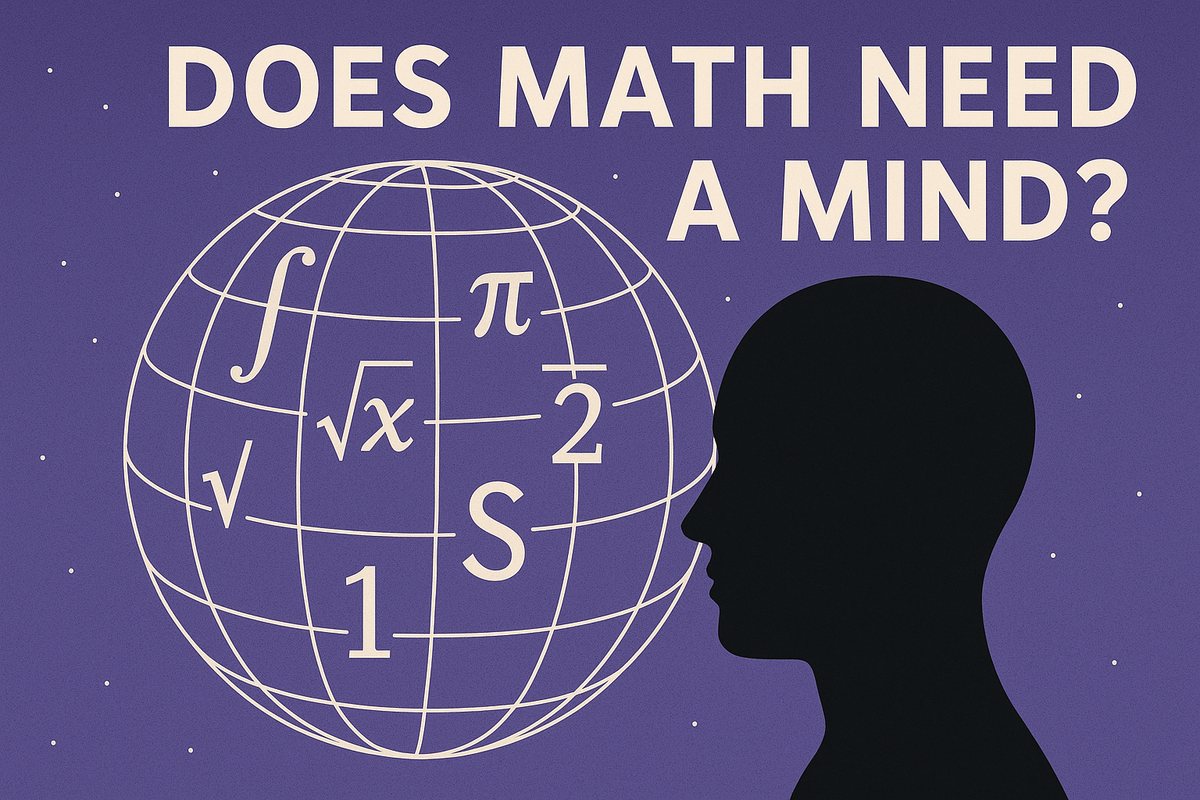Does Math Need a Mind?

There’s an audacious idea that's been batted around the physics and philosophy circles for years now. It says the universe didn’t need to begin, didn’t need to be caused, and didn’t even need to be made of matter in the first place. Instead, everything that exists might just be…math.
At first, that sounds poetic. But for physicist Max Tegmark, it’s literal. He argues that our universe doesn’t simply obey mathematical laws—it is a mathematical structure. The cosmos, in his view, isn’t made of particles or fields but of numbers and relationships. When you describe those relationships with equations, you’re not describing something external to them. You’re writing the universe itself.
It’s a bold claim: that physical existence and mathematical existence are one and the same. If that’s true, then maybe the universe doesn’t need a creator or even a cause. Maybe it just exists because mathematical truths exist.
Everything Is Mathematics
Tegmark calls this idea the Mathematical Universe Hypothesis. The central claim is simple but radical: every consistent mathematical structure exists in the same way that ours does. Geometry, algebra, and logic aren’t tools for describing reality; they are reality.
This means the universe has no “stuff” underneath the math. Matter, energy, and space-time are simply parts of a vast web of mathematical relationships. When you write an equation like Einstein’s E=mc², you’re not modeling a deeper layer of physical truth. You’re writing part of what the universe actually is.
If that sounds abstract, think of it this way: mathematical entities like triangles or prime numbers don’t need to be built or born. They exist timelessly, the way the number seven just exists. Tegmark’s suggestion is that the universe is the same kind of thing—a structure that exists eternally as a mathematical fact.
A Multiverse of Equations
Once you take that leap, a bigger idea follows. If one mathematical structure exists, why not all of them? Tegmark argues that every internally consistent system of equations defines a possible universe, and all of them exist equally. Ours happens to be the one that allows self-aware creatures like us to evolve and ask questions about it.
He calls this grand collection of universes the Level IV multiverse. It contains every possible set of laws, constants, and dimensions that can exist without contradiction. Each universe is timeless, complete, and uncreated. In this view, “existence” means mathematical consistency, not physical causation.
If that’s right, the universe didn’t begin. It doesn’t unfold in time the way we imagine. It’s more like a finished theorem sitting on the shelf of logic, complete from start to finish.
The “Why This Structure?” Problem
It sounds elegant, but there’s an obvious question. If all mathematical structures exist, why are we in this one? Why does this particular set of equations correspond to the world of galaxies, electrons, and cat videos?
Some physicists answer that with the anthropic principle: only universes capable of producing observers will ever be observed. In other words, we see this structure because it happens to be one that can see itself. That explanation works in a limited way, but it doesn’t go deep enough. It tells us why we’re here rather than nowhere, but not why there’s a “here” at all.
Even if every mathematical structure exists, we still face a basic mystery: what does it mean for an abstract equation to be real? A circle can be perfectly defined by math, but it doesn’t occupy space until someone draws it. How does a mathematical object “cross over” from abstract truth to concrete reality?
That is the ontological gap—the space between mathematical possibility and physical existence.
A New Kind of Cosmological Argument
This is where philosophy steps back in. For centuries, cosmological arguments for God tried to show that the universe must have a cause or a necessary ground. Tegmark’s idea eliminates the need for a temporal beginning, but it doesn’t remove the question of why anything exists. It simply restates it in a new form.
If mathematical structures exist independently, why do they exist at all? And what gives one of them the power to produce a living, causal world?
Some philosophers, including Alexander Pruss, Joshua Rasmussen, and Edward Feser, have used this to reformulate a modern version of the cosmological argument. It goes something like this:
- Mathematical structures are abstract and causally inert.
- At least one structure (ours) is realized as an actual, experiential world.
- Abstract existence alone can’t explain that actuality.
- Therefore, there must be something beyond mathematics that makes one or more structures real.
In this version, “creation” isn’t a moment in time but an act of actualization. Something must confer being on mathematical possibilities. Classical theism would call that “something” God.
Does Math Need a Mind?
This raises an even deeper question: can mathematics exist on its own, or does it require a mind to contain it? Many philosophers, going back to Augustine, have suggested that mathematical truths are thoughts in a divine intellect. If the universe is mathematics, perhaps it’s an expression of that eternal reasoning.
Tegmark’s version leaves the mind out entirely. The equations are just there, timeless and impersonal. But critics argue that abstract patterns don’t explain their own existence. They’re possibilities, not realities, and possibilities don’t make themselves real. Something has to “breathe fire into the equations,” as Stephen Hawking once put it.
That doesn’t necessarily mean a traditional deity. It could be some metaphysical principle of actuality, something that gives reality its “is-ness.” Either way, Tegmark’s theory doesn’t eliminate the need for grounding. It just moves the mystery up one level.
The Scientific Skeptics
Even among naturalists, the mathematical universe idea is controversial. Philosopher Tim Maudlin argues that saying “all mathematical structures exist” explains nothing; it simply expands your ontology to infinity. Hartry Field rejects mathematical realism altogether, suggesting that math is a useful fiction, not a realm of real entities. And physicist Sean Carroll points out that Tegmark’s theory makes no testable predictions, so it isn’t really science—it’s metaphysics dressed in scientific clothing.
Yet even its critics admit that the effectiveness of mathematics in describing the physical world remains an astonishing fact. The equations of physics don’t just work; they work too well. Why the universe seems to follow the logic of mathematics so perfectly is still one of the deepest puzzles in science.
Equations or God?
In an odd way, Tegmark’s mathematical cosmos and the traditional idea of God have more in common than either side might like to admit. Both are timeless, necessary, and self-existent. Both are said to contain all possible realities within them. Both are invoked to explain why there is something rather than nothing.
The difference lies in what each side considers ultimate. For Tegmark, it’s mathematical consistency itself. For the theist, it’s a necessary mind that understands and sustains those truths. The disagreement isn’t so much about physics as it is about what we mean by existence.
The Deeper Lesson
Whether or not the Mathematical Universe Hypothesis turns out to be right, it highlights something remarkable about human thought. As science digs deeper into the cosmos, the boundary between physics and philosophy keeps blurring. The question of origins, which once belonged to religion, now echoes in the equations of cosmology. And the answers, even when stripped of theology, keep pointing to mysteries that feel almost metaphysical.
Maybe the universe really is made of math. Or maybe math is just the language our minds use to make sense of something deeper. Either way, the question “Why does anything exist?” refuses to go away. We can push it higher or lower, rename it or reframe it, but it keeps resurfacing.
If the universe is an equation, we still want to know who—or what—wrote it.




